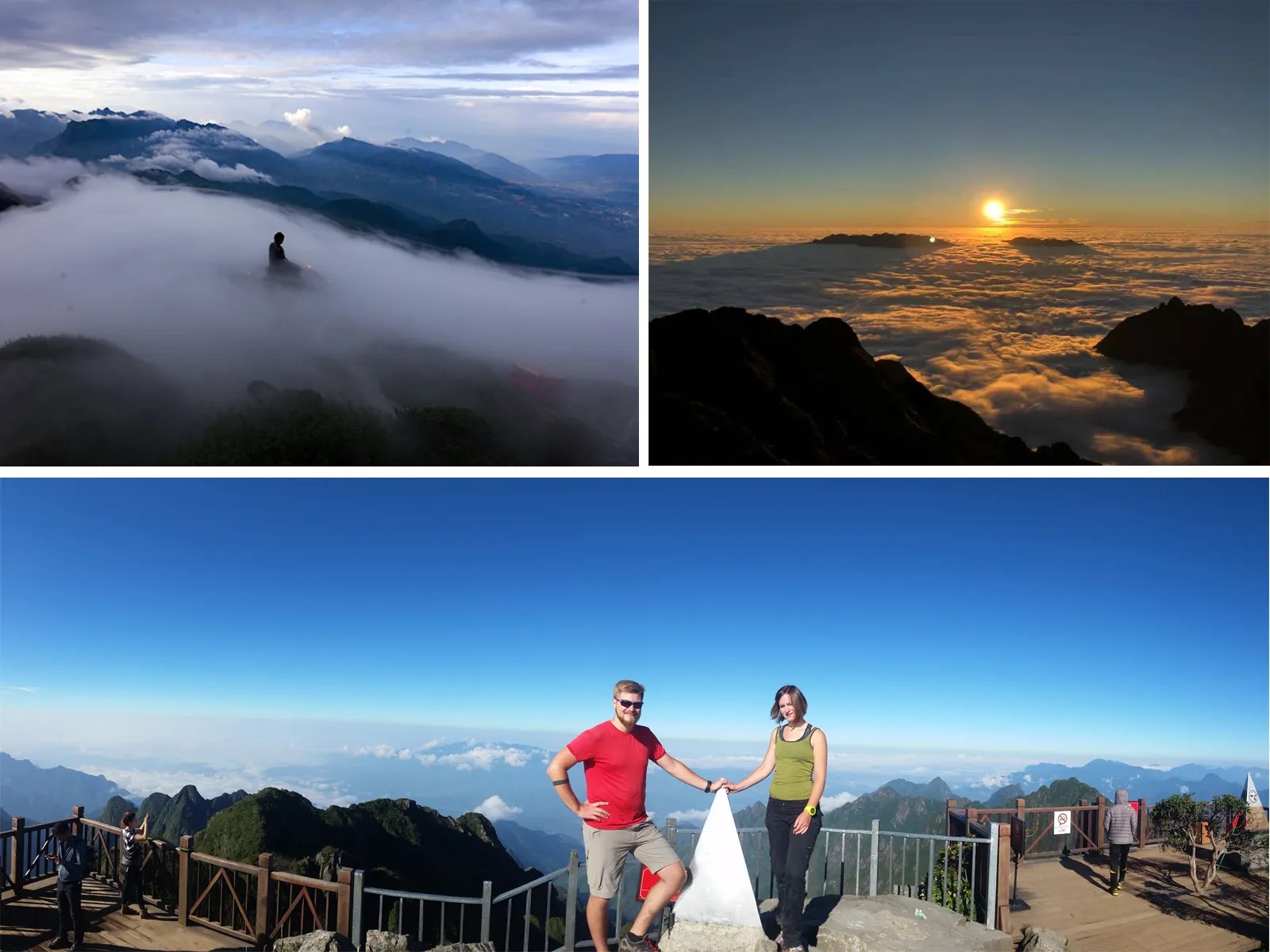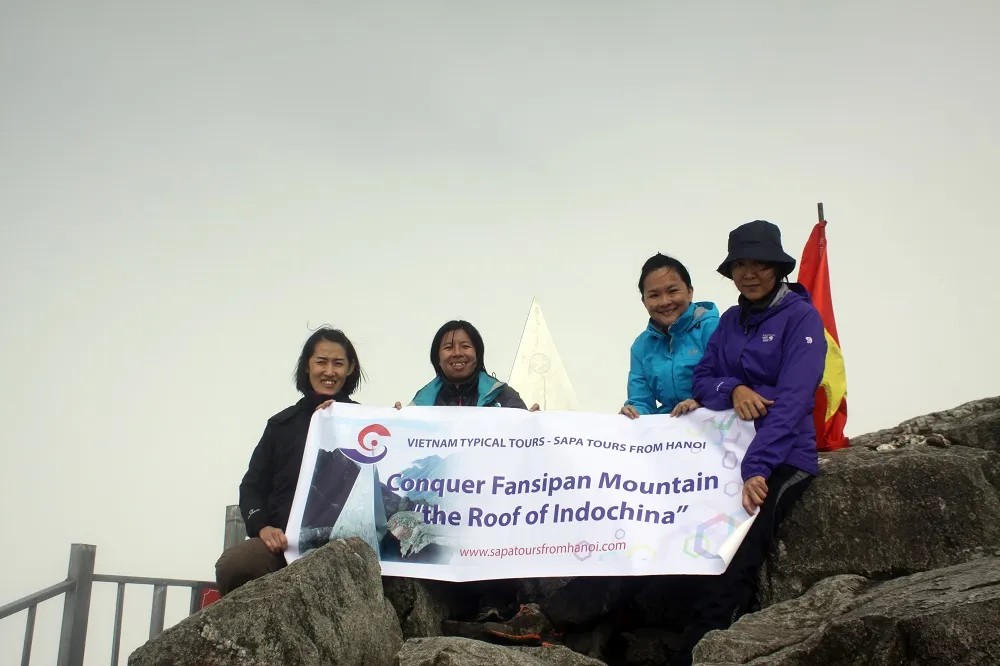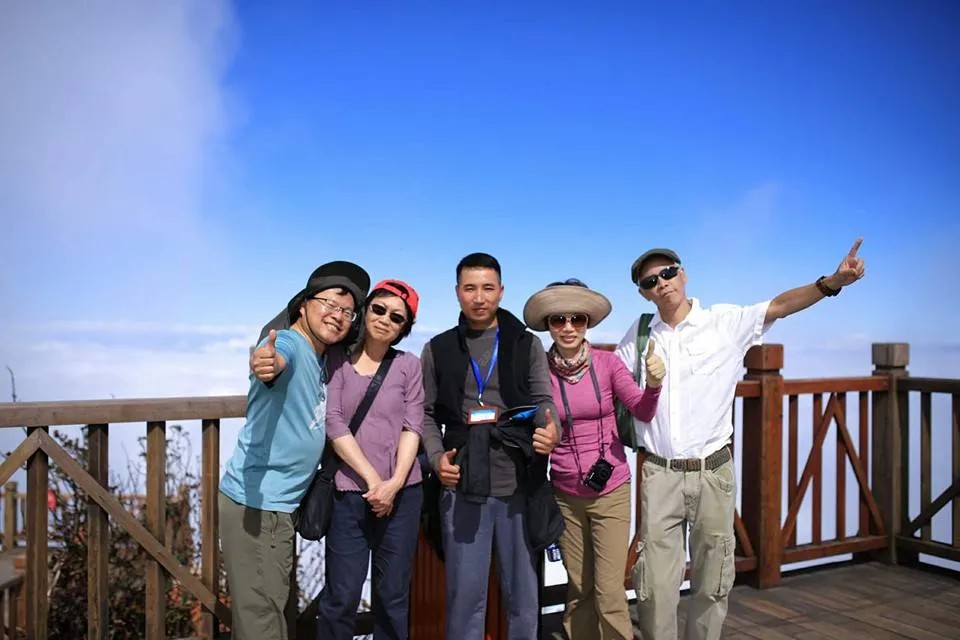Are you dreaming of conquering Fansipan, the “Roof of Indochina?” SIXT.VN makes your dream a reality! Whether you prefer a swift cable car ride or an adventurous trek, we’ll guide you to the summit. Let SIXT.VN be your trusted partner in crafting an unforgettable Fansipan experience, providing seamless travel solutions and expert advice. Explore Vietnam effortlessly with our comprehensive travel services including airport transfers, hotel bookings, and curated tours.
1. What Makes Fansipan So Appealing to Visitors?
Fansipan, standing at 3,143 meters (10,312 feet), holds the title of the highest peak in Indochina, beckoning adventurers and nature enthusiasts alike. According to the Vietnam National Administration of Tourism, Fansipan is one of the most visited destinations in Sapa, attracting both domestic and international tourists. Its allure lies in its stunning panoramic views, rich biodiversity, and the sense of accomplishment one feels upon reaching the summit. Whether you choose the modern cable car or the challenging trekking route, Fansipan offers an unforgettable experience.
2. What Are the Two Main Ways to Reach the Summit of Fansipan?
There are primarily two ways to reach the summit of Fansipan: by cable car and by trekking. Each offers a unique experience catering to different preferences and fitness levels.
2.1. Fansipan Cable Car: A Quick and Scenic Route
The Fansipan cable car offers a convenient and breathtaking journey to the summit.
- Speed and Convenience: The cable car whisks you to the top in just about 15-20 minutes, making it ideal for those with limited time or mobility.
- Panoramic Views: Enjoy spectacular views of the Muong Hoa Valley, lush landscapes, and the Hoang Lien Son mountain range.
- Accessibility: This option makes Fansipan accessible to a wider range of travelers, including families with children and the elderly.
According to Sun World, the operator of the Fansipan cable car, the system is designed to transport up to 2,000 passengers per hour, ensuring efficient access to the summit.
2.2. Trekking to Fansipan: An Adventurous Challenge
For the adventurous souls, trekking to the summit of Fansipan offers an immersive and rewarding experience.
- Physical Challenge: Trekking requires good physical fitness and preparation, as it involves several hours of hiking through varying terrains.
- Immersive Experience: Experience the natural beauty of the Hoang Lien Son National Park up close, encountering diverse flora and fauna along the way.
- Sense of Accomplishment: Reaching the summit after a challenging trek provides an unparalleled sense of achievement.
Various trekking routes are available, ranging in difficulty and duration, typically taking from 1 to 3 days. Local guides are highly recommended to ensure safety and navigation.
3. What Are the Pros and Cons of Each Method?
| Feature | Fansipan Cable Car | Trekking to Fansipan |
|---|---|---|
| Time | 15-20 minutes | 1-3 days |
| Difficulty | Easy | Challenging |
| Physical Fitness | Not required | Requires good physical fitness |
| Views | Panoramic views from above | Immersive views of the natural park |
| Cost | Higher (cable car ticket) | Lower (guide and permit fees) |
| Experience | Convenient and comfortable | Adventurous and immersive |
| Accessibility | Accessible to all | Limited to physically fit individuals |
4. How to Get to the Fansipan Cable Car Station from Sapa?
The Fansipan cable car station is located in the Fansipan Legend complex, approximately 3 kilometers (1.9 miles) from the center of Sapa town. Here are the most common ways to get there:
4.1. Walking
- Distance: Approximately 30 minutes.
- Route: From Sapa Stone Church, follow Thac Bac Street, then Nguyen Chi Thanh Street to the Fansipan Legend complex.
- Pros: Free, allows you to enjoy the town’s atmosphere.
- Cons: Can be tiring, especially on a hot day.
4.2. Taxi
- Duration: Approximately 10 minutes.
- Cost: Roughly 200,000 VND – 250,000 VND (approximately 8-10 USD).
- Pros: Convenient and quick.
- Cons: More expensive than other options.
4.3. Motorbike Taxi (Xe Om)
- Duration: Approximately 10 minutes.
- Cost: Negotiable, usually cheaper than a regular taxi.
- Pros: A fun and adventurous way to get there.
- Cons: May not be suitable for those with luggage or mobility issues.
4.4. Muong Hoa Mountain Train
- Duration: 4 minutes.
- Cost: Approximately 200,000 VND per person for a round trip.
- Route: Connects Sapa town (Sun Plaza) to the Fansipan cable car station.
- Pros: Offers scenic views of Muong Hoa Valley, comfortable and quick.
- Cons: Requires an additional transfer to the cable car station.
 Sapa Mountain Climbing Train: A scenic route to Fansipan cable car station
Sapa Mountain Climbing Train: A scenic route to Fansipan cable car station
5. What is the Muong Hoa Mountain Train and How Does it Work?
The Muong Hoa mountain train is a modern railway that connects Sapa town with the Fansipan cable car station. According to Vietnam Railways, this train reduces travel time and offers passengers stunning views of the Muong Hoa Valley.
5.1. Route and Duration
The train departs from Sun Plaza in Sapa town and arrives at the Sapa station (Muong Hoa station), located near the cable car terminal. The journey takes approximately 4 minutes.
5.2. Ticket Information
A round-trip ticket costs around 200,000 VND per person. The trains run continuously, minimizing wait times.
5.3. Design and Ambiance
The train station is designed in a European style, offering spacious and picturesque spots for taking photos. The large windows provide panoramic views of the surrounding landscapes, enhancing the overall travel experience.
6. What is the Do Quyen Mountain Train and When Should You Use It?
The Do Quyen mountain train is a shorter railway that takes you from the Fansipan cable car station to the summit area, reducing the need to climb the final 600 steps.
6.1. Purpose and Benefits
This train is particularly useful for:
- Elderly Travelers: Reduces physical strain for those who may find the climb challenging.
- Travelers with Health Conditions: Helps individuals with respiratory or joint issues avoid strenuous activity.
- Inclement Weather: Provides a safer and more comfortable option during windy or rainy conditions.
6.2. Ticket Prices
- One-way Ticket (Ascent): Approximately 150,000 VND.
- One-way Ticket (Descent): Approximately 120,000 VND.
6.3. What to See Near the Summit Station
The Do Quyen train allows you to save energy and time, enabling you to explore nearby attractions such as:
- Lower Temple (Ha Pagoda)
- Upper Temple (Thuong Pagoda)
- Do Quyen Flower Path: A scenic route adorned with beautiful Do Quyen flowers (azaleas), especially vibrant during the blooming season.
7. What Are the Fansipan Cable Car Ticket Prices for 2025?
As of 2025, the Fansipan cable car ticket prices are as follows:
| Day | Adult Price (VND) | Child Price (VND) |
|---|---|---|
| Monday – Friday & Sunday | 800,000 | 550,000 |
| Saturday & Holidays | 850,000 | 550,000 |
Note:
- Child tickets are for children between 1.0 meter and 1.4 meters in height.
- Children below 1.0 meter in height ride for free.
- Prices are subject to change, especially during peak seasons and holidays.
7.1. Important Tips for Purchasing Tickets
- Height Measurement: There is a height measurement point at the ticket counter to verify children’s eligibility for discounted tickets.
- Keep Your Ticket Safe: The ticket is valid for a round trip, so keep it secure for the return journey.
- Validity: Tickets are valid only on the day of purchase.
- Peak Season: During holidays and weekends, expect long queues. Consider booking in advance through local operators or hotels.
8. What is the Best Time to Visit Fansipan Mountain?
The best time to visit Fansipan Mountain is during the dry season, from October to May. According to meteorological data, this period offers the most favorable weather conditions for both cable car rides and trekking adventures.
8.1. Dry Season (October to May)
- Weather: Mild temperatures, clear skies, and minimal rainfall.
- Advantages: Ideal for enjoying panoramic views and outdoor activities.
8.2. Peak Tourist Season (November to February)
- Conditions: Pleasant conditions for experiencing the mountain’s natural beauty.
- Note: Expect higher tourist volumes during these months.
8.3. Weather Conditions at Fansipan
Fansipan experiences a subtropical highland climate. Temperatures range from an average of 5°C (41°F) in January to 18°C (64°F) in July. Snowfall is common at the summit during winter months.
9. What Should You Be Aware of Regarding Altitude and Temperature Changes?
Traveling to Fansipan via cable car involves a rapid altitude change of 1,410 meters (4,626 feet) in about 15 minutes. This can lead to:
9.1. Potential Effects
- Tinnitus: Ringing in the ears.
- Elevation Shock: Slight discomfort as your body adjusts to the new altitude.
9.2. How to Mitigate These Effects
- Deep Breathing: Take slow, deep breaths to help your body acclimatize.
- Appropriate Clothing: Bring warm clothing, such as a sweatshirt or jacket, as temperatures at the summit are significantly lower and the wind can be strong.
9.3. Health Precautions
- Medical Assistance: If you experience difficulty breathing or other abnormal symptoms, contact the station staff immediately.
- Walking Shoes: Wear comfortable walking shoes, as there are approximately 600 steps to reach the summit from the cable car station.
10. What is the Temple System in Fansipan and What Should You Wear?
Fansipan is not only a natural wonder but also a spiritual site, featuring a complex of temples and religious structures.
10.1. Temples and Statues
- Temple of Heaven (Thanh Phong Thien): Located near the Fansipan cable car station.
- Amitabha Buddha Statue: The highest bronze statue in Vietnam, standing at 21.5 meters (70.5 feet), symbolizing Fansipan’s spiritual culture.
- Kim Son Bao Thang Tu: A grand temple complex with intricate Buddhist statues.
- Great Bao Dai Palace: Featuring statues created by monks.
- Arhat Road: Adorned with 18 bronze statues of Arhats, lined with blooming Do Quyen flowers.
- Other Structures: Bich Van Thien, Bodhisattva Avalokitesvara statue, bell tower, and Son Than shrine.
10.2. Appropriate Attire
When visiting these sacred sites, it is important to dress respectfully:
- Modest Clothing: Wear clothing that covers your shoulders and knees.
- Polite Appearance: Avoid wearing overly revealing or flashy outfits.
11. What Dining Options Are Available at Fansipan Legend?
Fansipan Legend offers a variety of dining options to cater to different tastes and preferences.
11.1. Hai Cang Fansipan Restaurant
- Location: At Fansipan Terminal.
- Cuisine: Offers a range of European and Asian dishes, as well as Sapa specialties.
11.2. Van Sam Restaurant
- Location: At Hoang Lien Terminal.
- Cuisine: Similar to Hai Cang, providing a variety of options to suit different palates.
11.3. Menu Highlights
- Sapa Specialties:
- “Lợn cắp nách” (special pork)
- Salmon hotpot
- Grilled fish
- Other Options:
- European dishes
- Asian dishes
11.4. Unique Ambiance
The restaurants and coffee shops blend elegant French architecture with the cultural style of Northwest Vietnam.
12. What is Van Son Tea House and Why Should You Visit?
Van Son Tea House is a unique cultural spot located on the 600-step route to the Fansipan summit, near the Lower Temple.
12.1. Design and Atmosphere
The tea house’s design is reminiscent of Tru Vu Tea House in Ba Na Hills, featuring a traditional tea ceremony style.
12.2. Experience
Surrounded by clouds, you can enjoy:
- Hot Tea: Savor a cup of traditional Vietnamese tea.
- Do Quyen Flowers: Admire the beautiful azaleas blooming nearby.
- Inner Peace: Find a moment of tranquility and reflection.
13. Who Should Not Take the Cable Car to Fansipan?
While the cable car offers a convenient way to reach the summit, it may not be suitable for everyone:
- Respiratory Problems: Individuals with severe respiratory issues.
- Heart Problems: People with heart conditions.
- Fear of Heights: Those with a strong phobia of heights.
13.1. Important Considerations
- Air Thinness: At the summit, the air is thinner, which can exacerbate respiratory problems.
- Rest and Acclimatization: Allow your body time to adjust to the temperature and climate.
14. What Are the Provisions and Safety Guidelines for the Cable Car?
To ensure a safe and enjoyable experience, adhere to the following guidelines:
- Prohibited Items: Do not bring toxic chemicals, explosive materials, or prohibited substances onto the cable car.
- Cabin Behavior: Remain stable and avoid moving around while the cabin is in operation, especially with children.
- Wind and Stops: Be aware that the cabin may experience wind-induced shaking and occasional stops. These are normal and part of the cable car’s operation.
15. What Should You Pack for a Fansipan Cable Car Trip?
Preparing adequately for your trip will enhance your overall experience.
15.1. Essential Items
- Snacks and Water: Bring food and drinks to avoid hunger and dehydration, as prices on the mountain are typically higher.
- Warm Clothing: Wear warm layers suitable for climbing, as the temperature at the summit can be significantly colder.
- Sturdy Shoes: Essential for navigating the steps and uneven terrain at the summit.
- Lightweight Raincoat: Weather conditions can change rapidly, so a raincoat is a good precaution.
16. What Photo Opportunities Await You at Fansipan Mountain?
Fansipan Mountain offers countless opportunities for stunning photographs.
16.1. Scenic Spots
- Panoramic Views: Capture the breathtaking vistas of the surrounding landscapes.
 Beautiful view from Fansipan peak: Capture the majestic beauty of the mountain range
Beautiful view from Fansipan peak: Capture the majestic beauty of the mountain range
- Religious Structures: Photograph the intricate details of the temples and statues.
 Conquering fansipan by cable 3: A memorable shot at the summit of Fansipan
Conquering fansipan by cable 3: A memorable shot at the summit of Fansipan
- Natural Beauty: Capture the vibrant flora and fauna of the Hoang Lien Son National Park.
 Sapa trekking tours: A glimpse into the lush landscapes surrounding Fansipan
Sapa trekking tours: A glimpse into the lush landscapes surrounding Fansipan
17. What Other Activities Can You Enjoy in Sapa Besides Fansipan?
Sapa offers a plethora of activities beyond conquering Fansipan. Here are some popular options:
- Trekking: Explore the surrounding valleys and villages with guided treks.
- Visiting Ethnic Villages: Discover the unique cultures of the local Hmong and Dao communities.
- Exploring Markets: Experience the vibrant atmosphere of Sapa’s local markets.
- Waterfalls: Visit stunning waterfalls such as Cat Cat Waterfall and Silver Waterfall.
- Rice Terraces: Marvel at the picturesque rice terraces, especially during the planting and harvesting seasons.
18. How Can SIXT.VN Help You Plan Your Trip to Fansipan?
SIXT.VN offers comprehensive travel services to make your Fansipan adventure seamless and unforgettable:
- Tailored Itineraries: We create personalized travel plans based on your preferences and schedule.
- Airport Transfers: Enjoy comfortable and reliable airport pickup and drop-off services.
- Address: 260 Cau Giay, Hanoi, Vietnam.
- Hotline/Whatsapp: +84 986 244 358.
- Hotel Bookings: Choose from a wide range of accommodations to suit your budget and preferences.
- Tour Packages: Explore Sapa and Fansipan with our expertly curated tour packages.
- Ticket Assistance: We can help you book cable car tickets in advance to avoid long queues.
Let SIXT.VN take care of all your travel needs, so you can focus on enjoying the breathtaking beauty of Fansipan and Sapa. Contact us today to start planning your dream trip!
19. What Are the Benefits of Booking with SIXT.VN?
Choosing SIXT.VN for your travel arrangements comes with numerous advantages:
- Convenience: We handle all the details, from transportation to accommodations.
- Reliability: Our services are trustworthy and dependable, ensuring a stress-free experience.
- Expert Advice: Our knowledgeable team provides valuable insights and recommendations.
- Personalized Service: We tailor our services to meet your specific needs and preferences.
- Support: We offer 24/7 support to assist you with any questions or concerns.
With SIXT.VN, you can travel with confidence, knowing that you have a reliable partner every step of the way.
20. Frequently Asked Questions (FAQ) About Visiting Fansipan
20.1. How long does it take to reach the summit of Fansipan by cable car?
The cable car ride takes approximately 15-20 minutes.
20.2. Is it necessary to book cable car tickets in advance?
During peak season and holidays, it is highly recommended to book tickets in advance to avoid long queues.
20.3. What should I wear when visiting Fansipan?
Wear warm, comfortable clothing, including layers, as the temperature at the summit can be cold. Also, wear sturdy walking shoes.
20.4. Are there any age or health restrictions for riding the cable car?
While there are no strict age restrictions, individuals with severe respiratory or heart problems, or those with a strong fear of heights, should consult their doctor before riding the cable car.
20.5. Can I trek to Fansipan without a guide?
While it is possible to trek independently, it is highly recommended to hire a local guide for safety and navigation.
20.6. What is the best time of year to trek to Fansipan?
The best time for trekking is during the dry season, from October to May, when the weather is mild and there is less rainfall.
20.7. Are there any accommodations available on Fansipan Mountain?
There are no accommodations on the mountain itself. Most visitors stay in Sapa town and make a day trip to Fansipan.
20.8. Can I bring food and drinks to Fansipan?
Yes, you can bring your own food and drinks, which is advisable as prices on the mountain are typically higher.
20.9. Is there Wi-Fi available at the Fansipan summit?
Yes, Wi-Fi is available at the summit area.
20.10. What languages are spoken by the staff at Fansipan Legend?
The staff typically speaks Vietnamese and English. Some may also speak other languages, such as French or Chinese.
Ready to experience the majestic beauty of Fansipan? Let SIXT.VN be your guide. Visit our website at SIXT.VN or contact us at +84 986 244 358 to start planning your unforgettable adventure today! With our expert services, conquering the “Roof of Indochina” has never been easier or more enjoyable.



